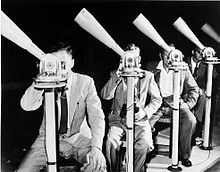Apogee telescope
The Apogee telescopes are massive lens telescopes that were used by the Smithsonian Astrophysical Observatory and the Moonwatch Organization for the worldwide visual observation of Earth satellites during the first two decades of space travel . The visual determination of the orbit was especially important for low-circling satellites, for twilight and reentry observations, for which photographic cameras were not suitable at the time.

The telescopes have an aperture of 13 cm and a focal length of about 60 cm, which means a high light intensity. The most commonly used eyepiece has a 20-fold magnification and a field of view of around 3 ° with a split thread network , so that very fast, not precisely predictable objects can also be observed.
Mount and observation method
Initially, the telescopes were used by groups of observers, each of whom monitored a small section of the sky that overlapped with its neighbor, where a satellite passage was expected (see picture).
When good orbit data and programs for forecasting were available in the 1960s, the work was transferred to individual observers. Many telescopes received heavy azimuthal mounts from military stocks (telescopic sights for tanks or artillery). They were equipped with graduated circles that allowed the azimuth and elevation angle to be read off to about 1–2 minutes . With the mount that was quickly trackable, satellites could be followed at 1 ° per second (400 km orbit height). In the case of even faster ones (about just before re-entry into the atmosphere), one waited at precalculated places for the satellite and estimated its crossing on the thread net.
The time was measured with a good stop watch connected to a time signal. It was accurate to about a tenth of a second when the observer's reaction time (about 0.2-0.3 s) was taken into account.
Re-use until today
The visual observation programs ended around 1975, but most of the telescopes remained with the participating amateur observers . The very bright telescopes are particularly suitable for diffuse, weak celestial objects such as comets or galactic nebulae , but because of the relatively large field of view they are also suitable for extensive nearby star clusters that would only be partially visible in a larger telescope.
In some observatories, the very robust Apogees are still used as finderscopes for very large lens telescopes. They weigh about 15 kg and were built for military use in the 1950s, but soon passed on to satellite organizations.
See also
- Time error in satellite measurements
- Kinetheodolite , satellite camera
- Comet seeker
- Scissors telescope
literature
- Nelson Hayes: Trackers of the Skies . Howard Doyle Publ. 1968 and Academic Press 1975
- Kurt Arnold : Methods of Satellite Geodesy , Chapter 5 Observation Methods . Akademie-Verlag, Berlin 1970
